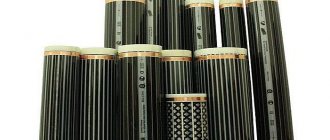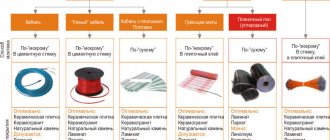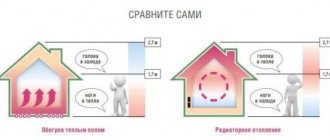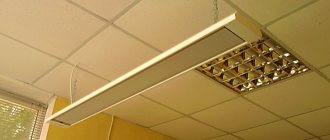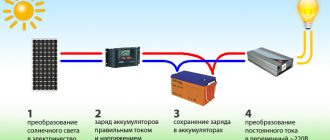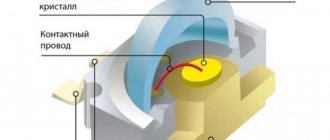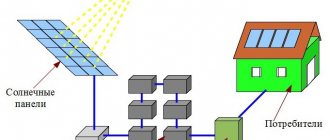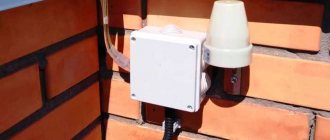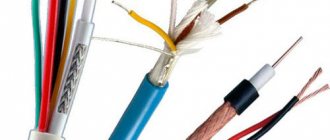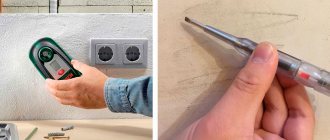SHARE ON SOCIAL NETWORKS
FacebookTwitterOkGoogle+PinterestVk
Previously, installing infrared flooring was considered a luxury, however, today this method of heating rooms has gained wide popularity. Infrared film heated floors are a modern and practical option for organizing primary or additional heating in a room. In this article we will look at the benefits of installing infrared film, its types and compatibility with floor coverings.
Thanks to infrared film heaters, an economical and efficient underfloor heating system can be built in a matter of hours
Infrared heated floor: pros and cons
Heating using IR film has many advantages over other types of similar heating. Let's consider the main advantages of this heating design:
- such a system cannot fail at the same time, since it is connected in parallel;
- possibility of installation on any type of surface - both horizontal and vertical, as well as on elements that are located at an angle;
The film does not contain components hazardous to human health, does not produce unpleasant odors or toxic fumes
- The design features of the infrared floor make it possible to achieve uniform heating of the room. This is especially important if laminate is used as a floor covering;
- another advantage of such a system is ease of installation;
- possibility of disassembly if necessary;
- this film is suitable for installation in rooms where the humidity level exceeds the permissible parameters;
- compatibility with different flooring options;
- installation of such a system is allowed not only in enclosed spaces, but also in open conditions (for example, on a veranda);
- high heat transfer coefficient, which reaches 97%;
- The efficiency of film infrared flooring is approximately 30% higher than that of other underfloor heating systems. The prices of film heated floors fully correspond to their effectiveness.
Note! When choosing IR film for organizing floor heating, you need to take into account one very important parameter - the height of the ceilings. The lower the ceiling height, the more efficient the heating of the room.
However, this design also has some disadvantages, among which are the following:
- the need to follow clear rules when connecting;
Unlike other heating systems, infrared floors act directly on the surfaces of heated objects and do not dry out the air in the room at all
- high inertia, due to which heating and cooling occur very quickly;
- poor resistance to mechanical stress in comparison with a tubular structure that uses water as a coolant.
The film system is generally not suitable for installation as the main heating system. It is recommended to use an infrared design for additional heating.
Flooring installation
Even when a laminate is laid over IR film, it is advisable to protect the film from mechanical damage by laying polyethylene film, sheets of plywood or fiberboard with a thickness of 3 mm or more on top of it. Well, if linoleum or carpet is chosen as the finishing material, this should be done. It is clear that these are additional costs, but they are justified.
Types of infrared films
From a design point of view, all IR films are similar and have a common operating principle. However, for various types of premises and operating conditions, it is customary to use certain options for film heated floors. The differences between ICs are primarily due to the fact that they are produced by different companies.
Let's consider the types of IR film based on maximum heating temperature and their compatibility with various floor coverings:
- high-temperature infrared heated floors under tiles. The maximum heating temperature of such systems reaches 50°C. They are incompatible with floor coverings that are more susceptible to heat (linoleum, laminate);
In their structure and principle of operation, all infrared films are similar to each other, the main difference is the maximum heating temperature
- low-temperature infrared heated floors for linoleum and laminate. Such systems can heat up to 27°C;
- universal IR systems that are compatible with all types of floor coverings.
The second parameter by which IR films are classified is the type of heating element. Today, there are two main types of infrared floors, depending on the heating element:
- carbon;
- bimetallic.
The power density of the infrared floor is the last indicator, which is very important when choosing heating. Let's consider three main types of IR films, depending on this parameter:
- with low power (130–160 W/m²) - used in cases where it is necessary to organize heating of a room with a small area. Compatible with “light” floor coverings;
Infrared films from different manufacturers may differ in appearance and technical parameters
- with average power (from 170 to 220 W/m²) - installed in more spacious rooms. Perfect for the following flooring options: porcelain stoneware, tiles;
- with high power (above 220 W/m²) – installed in industrial buildings. They are also used for floor heating in saunas and various workshops.
If necessary, you can always contact specialists who will help you choose the necessary system for a particular case. It is also recommended that before purchasing, read the relevant reviews on specialized forums. Film heated floors are an innovative solution for any room, allowing you to achieve maximum comfort.
Features of carbon and bimetallic IR films
Carbon films used for underfloor heating are more expensive. The heating elements in such a system are made of a special carbon material, which has a fibrous structure. In some cases, they are equipped with a protective layer of graphite. Spraying of this material helps to increase the strength characteristics of the system and also affects the length of its service life.
The basis of the material is represented by lavsan film. Carbon infrared film flooring can be mounted on horizontal and vertical surfaces.
Scheme of bimetallic infrared film for heating
Helpful information! When installing carbon film for a heated floor, the choice of connection diagram is very important. In such a situation, experts recommend using a parallel connection option.
Bimetallic IR film differs from carbon film in that it has heating elements consisting of two metal layers (aluminum and copper). The material is based on double polyurethane film, which has good elasticity.
The installation of a bimetallic system is complicated by the fact that a ground electrode cannot be connected to the system. Also, the bimetallic structure is incompatible with ceramic flooring. It belongs to the low-temperature variety, so its recommended heating level does not exceed 27°C.
Features of this heating system
A film-type warm floor is a rather complex electrical system that you certainly cannot make yourself, but it is possible to purchase this film and install it yourself. You just need to have a general understanding of how to work with electrical devices, as well as follow all the rules for laying this product.
IR film for heated floors
A film floor can be called a universal heating system, since in some cases it can replace heating in a small room and also help create comfort in it. The film itself has special heating nanoelements, which are made of carbon-containing materials. Under the influence of electric current, they can create infrared radiation, due to which the surface is heated. The radiation is not noticeable to the human eye, but the body will immediately feel it.
Types of IR film floors
The nanoelements themselves are closed on both sides with a special polymer material, as if sealed inside it. The width of one strip of carbon substances is only 15 mm, and there are a lot of them on one piece of film. They are parallel to each other, and the film looks striped. The strips of heating elements are connected to each other by special silver-plated copper busbars. Thanks to the polymer film covering the heating strips on both sides, the system is protected from a number of influences, including moisture.
SNiP 2.04.05-91. Heating, ventilation, air conditioning. Downloadable file (click the link to open the PDF in a new window).
SNiP 2.04.05-91
Table. Some characteristics of the heating element.
| Parameter | Meaning |
| Film roll width | 50-100 cm |
| Length of material in 1 roll | 50 m |
| Material thickness | 0.2-0.4 mm |
| Power (consumption) | 25-80 W/h per 1 sq. m. |
| Possible heating level of the carbon element | 30-50 degrees |
Specifications
Technical characteristics and operational scope of film flooring
Before purchasing IR film, it is imperative to study all its main technical characteristics. This knowledge will help you select the required type of system and calculate it for a specific room. Let's consider the characteristics of such heating structures:
- IR film is produced and sold in rolls, the length of which reaches up to 100 m. The width of the roll can be different (from 50 to 100 cm), and its weight is approximately 55 kg;
Rolls of IR film come in different widths - from 50 cm to 1 m, their thickness can be from several microns to several millimeters
- the finished structure is powered from the electrical network, the voltage of which is standard 220V;
- per day, the IR floor consumes approximately 20 to 70 W/m²;
- the speed of heating the film to the maximum temperature is quite high (about 2 minutes);
- surface temperature can reach 50°C.
If you decide to use such a film as the main heat source, then you need to remember that it must cover at least 70% of the floor area. In regions with cold climates, film electric heated floors can only be used as additional heating.
VIOLET FLOOR 130
| Manufacturer: | VIOLET FLOOR |
| View: | heating film |
| Type of heating: | infrared |
| Power per 1 m2: | 130 W |
| Equipment: | per cut |
| Length: | 1m |
| Width: | 0.5 m |
| Heating area: | 0.5 m2 |
| Installation type: | dry installation |
for comparison
430 rub. per linear meter
Product added to cart
| Photo | Name | Price per piece | Quantity | Price |
| VIOLET FLOOR 130 | 430 rub. per linear meter | < 1 > | RUB 430,430 |
There are 0 items in the cart worth 0 rub.
Go to cart
Buy
Availability
Film heated floors Caleo
Caleo has a wide range of infrared films for underfloor heating, making it easy to choose the right system for a specific situation. The products of this brand are represented by both simple options and ultra-modern film coatings, the operation of which is as automated as possible.
Today this company produces 4 main modifications of infrared film systems.
Caleo IR film is sold complete with an installation kit: contacts and bitumen insulation, some also include connecting wires
LINE. An inexpensive system that is perfect for installation in small spaces.
GRID. A product belonging to the middle price segment. A special feature of the GRID infrared floor is the presence of an anti-spark mesh, which is made of silver.
Note! Caleo warm floors have their own characteristics. For example, their installation should be done only using the “dry” method. They are also not suitable for installation under ceramic floor coverings.
GOLD. As in the previous case, anti-spark mesh technology is used here. And also such films can self-regulate, which allows reducing energy consumption by up to 20%.
PLATINUM. The most expensive option for infrared flooring. It is distinguished by energy-saving qualities that can reduce electrical energy consumption by 5-6 times. IR flooring PLATINUM can be installed under areas that are covered by furniture, without the danger of overheating.
All of the above models have a remote control function. Installation of Caleo heated floors is carried out without the necessary organization of screed or special adhesive coating.
Caleo infrared film can be used as a main and additional heating system in almost all types of premises
Installation of heating elements and additional equipment
The film should be laid in strict accordance with the instructions specified in the technical documentation supplied with the product. There are no uniform standards, since the technical requirements of all manufacturers are different.
After cutting the film, be sure to insulate the copper bars at both ends!
We can only give general recommendations:
- Lay strips of material in such a way as to reduce to a minimum the length of electrical wiring and the number of points for connecting wires to the main and additional equipment.
- Carefully insulate electrical connections. Bitumen insulation is well suited for this purpose.
- Place the temperature sensor (if there is one) closer to the center of the room. This way he will convey more objective information.
- Place the thermostat in an accessible place so that problems do not arise if during operation there is a need to reprogram or replace the device.
- Select the type and cross-section of wires taking into account the total power of the heating system.
After completing installation, run the equipment in test mode and make sure that all components are functioning normally.
Also, for clarity, watch the video instructions:
Infrared film floors from the Rexva brand
Rexva IR films occupy second position in the ranking of heated floors. This company produces ultra-thin film communications that can be installed on various types of surfaces (vertical, horizontal and even on the ceiling). The Rexva range of heated floors is represented not only by systems with a standard power range.
For heating residential and industrial premises, this company offers infrared films, the power of which reaches 400 W/m². As a rule, such models are used to organize heating in saunas. They are characterized by a high level of water resistance, as they have a special double-sided coating located on top of the main lamination.
Products from the Rexva brand are highly durable and resistant to high pressure. Their operational scope is quite wide - from small rooms to gyms. The price of the Rexva infrared floor fully corresponds to good quality and reliability.
New film floors from RexVa have appeared on the market with a self-regulating effect, that is, with local overheating, it changes its own heat transfer in this area
Popular brands
The next stage is the choice of a manufacturer and a specific model of heated film floor. Judging by expert assessments and user reviews, the most popular are products from companies from South Korea :
- Caleo. The company specializes in the development and manufacture of infrared heating systems. In a short period of time, it gained a foothold in the climate control equipment market and became one of the recognized leaders in its price segment.
- Eastec. Another manufacturer actively promoting its products in different regions of our country. Consumers like not only the good quality of the products offered, but also their affordability.
- RexVa. Having made a choice in favor of this brand, you can not only purchase ready-made installation kits, but also buy cut-to-length IR film, completing it as you wish.
It is curious that the well-known company Electrolux, whose catalog also includes heated film floors, manufactures products in this category at factories also located in South Korea. But you have to pay for a well-promoted brand, and high prices force many buyers to look for products at more affordable prices.
Features of IR films from Heat Plus
The Heat Plus brand produces heated floors (including infrared). The peculiarity of the models manufactured by this company is that they can have different film shapes, namely:
- striped;
- solid.
Related article:
Do-it-yourself water heated floor, video and description of the process
Description of the installation process of a water heated floor. Its advantages and disadvantages are different from other types.
Features of the IR floor production technology from this company make it possible to avoid the presence of unheated zones. The production of such film systems involves uniform application of carbon material on a polyester base, which allows achieving a high level of efficiency of heating communications.
Let's look at other advantages of Heat Plus IR floors:
- ease of installation;
- wear resistance;
Infrared film Heat Plus consists of safe and environmentally friendly materials and is a coating with a thickness of 0.338-2 mm, consisting of 5-9 technological layers
- reliability.
The service life of such products can reach 15 years under normal use. If desired, organizing such a system takes no more than one day, which is very convenient.
Note! The price of IR floor Heat Plus is several times higher than the standard one. However, products from this brand pay for themselves in 1-2 years.
Principle of operation
The infrared heated floor is laid under the final floor covering (laminate, linoleum, tiles, etc.). If electric and water heated floors simply heat the coating located above them, and it already heats the air (convection method), then IHP acts differently. Infrared rays pass through the floor covering and affect all objects located indoors, including humans. These objects warm up the air in the room.
About 90% of ITP radiation consists of rays of the far infrared spectrum, and have a wavelength in the range of 5–20 microns. It is in this range that the human body is accustomed to working (the range of 5–20 microns is characteristic of solar rays). This means that, to some extent, infrared heated floors are an analogue of solar heat. In order to understand how ITP works, you can make a stand where you place a small piece of water, electric and infrared heated floors. In contrast to the first two, heat will only be felt in close proximity (maximum, at a distance of 5–10 cm), since their level of infrared radiation is negligible. The heat from the ITP will be felt at a distance of a meter or more. It is important to understand that such a “range” does not mean that IHP is more powerful than water and electric heated floors. It’s just that, due to special radiation, a warm floor has a different operating principle: it heats only objects, not air.
On the other hand, it should be borne in mind that infrared heated floors also have negative reviews. In science, there is the concept of an absolute black body (ABB) - a substance that absorbs any radiation. Conventionally, the blackbody is indexed by the number 1. The lower the throughput of the material, the closer its index is to one. And most floor coverings (linoleum, tiles, laminate, etc.) have a “blackness” index of around 0.9. In practice, this means that infrared radiation weakly penetrates the floor, which means that its principle of operation is in many ways similar to water and electric heated floors: first the floor covering is heated, and from it the entire room is heated. However, a certain amount of radiation still penetrates through the floor.
Warm floor infrared film Monocrystal
The Monocrystal company is located in Ukraine and is the only manufacturer of IR floors in the CIS. Thanks to South Korean technologies used in the manufacturing process of IR films, products from this brand have taken a confident position in the construction market.
The main difference between Monocrystal models is that they do not contain silver paste. To achieve the necessary electrical contact, products from the Ukrainian brand are equipped with a thicker layer of carbon paste. In this way, stabilization is achieved between the copper busbar and the heating device.
Let's look at the main technical characteristics of Monocrystal IR floors:
- film width – from 30 to 60 cm;
Special graphite film for tiles - produced by the Ukrainian company Monocrystal
- step – 20–25 cm;
- powered by an electrical network with standard voltage (220V);
- maximum power indicator – up to 200 W/m²;
- The maximum heating temperature of the material reaches 50°C.
The service life of IR film from the manufacturer Monocrystal is 10 years. The model range includes the following varieties: linear, perforated, solid. Perforation is arranged for compatibility with tile flooring. Film heated floors under tiles are widely popular among buyers.
Advantages and disadvantages
Like any complex engineering equipment, film heated floors have their own strengths and weaknesses, which you should be aware of before making the final decision to install such a heating system. Their advantages include:
- Easy installation. True, as it becomes clear from the above, this simplicity is relative.
- Low cost of materials. The point is not only that the consumables themselves are inexpensive. There is no need to purchase dry mixtures necessary for laying structural elements in the screed.
- Saving free space. Due to the thin film thickness, the distance between the floor and ceiling is reduced slightly.
- Health safety. Infrared heat sources do not dry out the air and do not generate inductive currents.
But, in no case should we forget about the shortcomings, the most significant of which are:
- High level of energy consumption. If this is the only heating system, the average electricity consumption will be about 1.5 kW/hour for a room of 20 square meters. meters.
- Fast cooling after a power outage. These are not massive cast-iron radiators or a stove that can retain heat for hours.
- The need to place furniture and other interior items in strict accordance with the layout of the heating elements. Simply buying a larger wardrobe, or replacing a one-and-a-half-size bed with a double bed will not work.
It is advisable to take all this into account in advance. And if this article helped you make a final decision regarding the advisability of installing heated film floors, then it has served its purpose.
Subscribe
Infrared heated floors: consumer reviews
Today, many home craftsmen refuse to install water-heated floors and give their preference to infrared floors. This is primarily due to the fact that a water system requires a longer installation time. And also its use is possible only after the screed has completely hardened. On many construction forums, consumers recommend infrared film heated floors. Reviews about these models are mostly positive.
The infrared energy emitted by carbon elements is completely identical to that emanating from the Sun, which is why it is so comfortable to be in a room with such heating
Consumers also pay attention to the efficiency that manifests itself in the process of using such heating systems. Studying various comments, you can see that many people point to savings in energy consumption with film heated floors. Reviews talk about saving electrical energy when using such systems by up to 20%.
Helpful information! Some IR systems take no more than 3 hours to install and can be used immediately after installation.
Such heating communications are considered completely safe and are repairable. If individual segments of the IR system are damaged, it does not fail completely. In addition, they can be easily replaced and continued operation of the system, which is often indicated in reviews. Warm floors under laminate are in great demand and usually cost the most.
Negative comments are much less common and, as a rule, indicate that when replacing the system, it becomes necessary to dismantle the floor covering. Most often, infrared heated floors are installed under laminate. Negative reviews in this case tell us that this floor covering cools down very quickly and the heating system cannot be used as the main one.
Laying and connecting film IR heaters does not require special training and can be done by hand
Accurate calculation required
An example of an infrared heating project
Before purchasing components, you should determine the characteristics of the heating system by making preliminary calculations. You will have to take into account not only the volume of the heated space, the climatic conditions characteristic of the region and the specific power of the heating elements. Meaning:
- The thickness of walls and ceilings, as well as the characteristics of the materials from which they are made.
- Glazing area and design features of window frames. In the accompanying documentation, bona fide manufacturers indicate thermal conductivity parameters.
- Thermal conductivity properties of floor covering laid on top of IR film.
- The presence of other, main or auxiliary heating systems.
Drawing up a connection diagram for a film heated floor
In order to avoid installation errors and other surprises, experts advise choosing a connection diagram and drawing up a project plan before installing IR film. An elementary diagram will help not only to correctly calculate the amount of material needed in a particular case, but also to select the film required in terms of power.
Let's consider the points that need to be taken into account when drawing up a connection diagram:
- cutting of infrared fabric is carried out strictly in those places that were marked by the manufacturer;
- It is strictly forbidden to cut at any angles and try to form shaped elements from the canvas;
- installation of the film is carried out in parallel strips;
- the strips must be laid in such a way that they do not overlap each other;
- It is important to remember that the gap between the film sheet and the furniture should not be less than 3 cm. The same distance must be maintained between the edge of the infrared sheet and the wall;
- copper bars of adjacent panels should not touch. The minimum distance between them is 1 cm;
- the number of connection points should be kept to a minimum;
Connection diagram for infrared film heater
- the best option for locating the connection points is on the side of the wall on which the thermostat will be installed;
- the diagram must be drawn up in such a way that the main part of the wiring is hidden behind the baseboards;
- when using short film sections (up to 100 cm), it is necessary to take care of additional insulation and purchase additional terminal clamps.
Helpful information! The individual panels are joined together using adhesive tape.
The thermostat must be selected in advance, before installing the electric heated floor. Reviews about these devices can be easily studied on specialized forums on the Internet. If the area that needs to be heated is quite large, then you need to purchase additional temperature sensors.
Preparing the base for laying infrared film
After choosing a laying scheme and purchasing material, you can begin pre-installation preparatory work. A very important point is preparing the base for laying the infrared floor. If the old concrete screed is not even, then it must be dismantled. However, if everything is in order with the screed, it is enough to simply clean it of debris and remove dust.
To prevent heating towards neighbors living on the floor below, it is necessary to lay heat-reflecting material for infrared heated floors
In most cases, the base has many small cracks and chips before laying the film. Experts advise eliminating these defects using cement mortar or any other suitable composition. In some situations, owners discover that the screed has begun to peel off from the subfloor. This situation requires the removal of the old screed and the organization of a new one.
The joints that form from connecting the walls to the floor must be carefully leveled and sealed if they have cracks. If this is not done, then the film floor will lose heat through them.
After preparing the base, it is necessary to lay thermal insulation material on the screed. As a rule, a reflector made of foamed polyethylene is used for these purposes. The joints of the individual insulator sheets are glued with mounting tape, and this is where the process of preparation for installation of the infrared heated floor ends.
A few words about safety
Film floors are considered safe for human health. They do not have a negative effect on the body during operation. But on the other hand, it is important to install them correctly, insulating all contacts to avoid electric shock. Otherwise they are completely safe. There is no need to be afraid of electromagnetic radiation - its level is negligible to cause harm.
Infrared heated floor
There is an opinion that the presence of such floors in the house improves the microclimate. And also some note a decrease in the recurrence of allergic reactions to anything.
Features of laying film heated floors under laminate
After completing the preparation process, you can proceed directly to installing the IR film. The installation algorithm for a heated film floor under a laminate is as follows:
- First of all, it is necessary to cut the material. The length of the strip should not be more than 8 m;
Before laying the infrared film under the laminate, it must be cut correctly
- At the second stage, the strips are laid. In order to reduce the number of joints, experts recommend laying sheets of infrared material along a long wall. The distance from the edge of the film to the wall should be at least 10 cm, and the distance between adjacent panels should be at least 5 cm. Installation of film heated floors is best done using the parallel method;
- Next you need to connect the wires and insulate unused contacts. The wires are connected using special clamps - terminals. And for insulation, a special bitumen tape is used, which has a high sealing coefficient;
- then the infrared floor wires are connected under the laminate. To do this, you need to connect the wire to the terminal and insulate it;
- At this stage, the temperature sensor(s) are installed. Experts advise placing these elements under the second canvas (closer to the midpoint). The sensor is installed in this way: it must be glued to the underside of the canvas on the black strip;
- Next, the infrared heated floors are connected to the thermoregulatory device. To do this, you need to connect the wires from the film and the temperature sensor to it. The connection itself is made through an RCD;
When installing IR film, you should use only special types of laminate that are designed specifically for such systems
- Next, you need to check how the installed communication functions. To do this, a trial run is carried out;
- The last stage of installing an infrared floor involves laying the appropriate floor covering on top of it, which in this case is represented by a laminate.
Helpful information! The wire belonging to the sensor can be placed in corrugated protection. This will simplify the repair procedure if necessary.
It is recommended to keep it in the room for 2-3 days before laying the laminate flooring. This is necessary so that it acquires the appropriate temperature, which will further prevent its expansion. To become familiar with the features of using IR film in this case, it is recommended to read reviews on specialized websites. Film heated floors under laminate are the most common today.
Installation of infrared heated floors under tiles
Laying an infrared floor under ceramic tiles can be done in two ways: “dry” and “wet”. In the first case, the heating elements of the film do not come into contact with the cement screed. In turn, the “wet” method of installing IR film is done by pouring cement mortar over the system.
Two schemes for connecting film heated floors under tiles
Let's consider the algorithm of the method:
- Installation of the film sheet, which is carried out according to the same rules as in the case of organizing infrared heating under the laminate.
- Next, a protective layer is installed, which is often used as a polyethylene film.
- At this stage, it is necessary to install a base under the screed on top of the film. Plasterboard sheets (GKL) are excellent for such purposes. When fixing the sheets, special care must be taken, as there is a risk of damage to the heating elements of the infrared floor.
- Then a thin layer of screed is poured over the substrate.
- The last step is to lay the tiles. For this, standard tile adhesive is used.
In turn, laying infrared heated floors using the “wet” method is more profitable from a financial point of view. It includes the following steps:
- First of all, it is necessary to install the heating elements of the IR floor;
Laying the infrared film sheet under the tiles is carried out according to the same rules as under other coatings
- Next, a protective polyethylene film is laid. This stage is the most important in the entire procedure of the “wet” method of installing IR. Experts recommend laying protective polyethylene film in 2-3 layers;
- At the third stage, reinforcement is installed. As a rule, a metal masonry mark is used for these purposes;
- then the screed is poured;
- Finally, ceramic tiles must be laid.
Note! The thickness of the screed should not be more than 10 mm, otherwise the efficiency of such heating will be significantly reduced.
Thus, the installation of film heated floors under tiles can be done by hand. The only thing that is necessary for this is strict adherence to the sequence of work.
Two methods of laying infrared film under ceramic tiles: “dry” and “wet” methods
Which system is more economical?
To determine cost-effectiveness, consider how the system is used. If the room is heated only with a film floor, the energy consumption is almost half that of a cable electric heated floor.
The following is considered a big disadvantage: after turning off the heating, the room cools down quickly, almost immediately. If we compare infrared flooring with cable flooring in this parameter, then the latter is much more economical.
Cable covered with tie
After disconnecting the cable structure, the room does not immediately cool down, since the screed accumulates heat during operation, and releases it after disconnecting the energy source.
Features of installing film heated floors under linoleum
Installing an infrared floor under linoleum has its own characteristics. Let's look at this process step by step:
- First, the thermal insulation material is laid.
- Next, you need to cut the IR fabric into pieces of the required length.
- At the third stage, film heated floors are installed. It is important to remember that they must be laid with the copper elements facing down.
- Then, using pliers, clamp terminals are mounted on the copper wire elements of the film.
- At this stage, the strips are fixed with double-sided tape. This is necessary in order to avoid their free movement.
- Next, you need to complete the procedure for connecting the heated film floor to the electrical network.
- After connecting the IR floor, you need to check its functionality.
- Then a protective polyethylene film is placed on the heating elements, which is fixed with tape.
- The penultimate stage takes into account the installation of the base under the linoleum. Fiberboard sheets can be used as a base.
- At the last stage, the linoleum is laid.
The packaging with a roll of linoleum must have a pictogram indicating the possibility of using it in combination with heated floors
Thus, a film heated floor is installed under linoleum. If you are not confident in your own skills, then it is recommended to contact the masters who will do all the work efficiently and in a matter of hours.
Choosing the right one
Be sure to use the recommendations of experts to ensure that your heated floor lasts a long time and is easy to use. A few useful tips will help you choose the right infrared coating.
- A film that is already beginning to delaminate is not suitable for use. This is a sure sign of low quality.
- The material must be clean, free of debris, without foreign particles inside. There should also be no stains or any dirt. Be sure to unroll the roll and check.
- It is important to ensure uniformity: the printing of the carbon layer must be uniform.
- When purchasing, you will need to check the geometry of the material. A high-quality roll has straight edges and a smooth surface.
- The insulation of the wiring of a rod-heated floor plays a huge role: the safety of the entire system depends on it. Make sure the insulation is reliable and intact.
Important! It is necessary to distinguish materials by their types. Matte is optimal for a higher level of thermal insulation, while transparent is more suitable for successful gluing.
